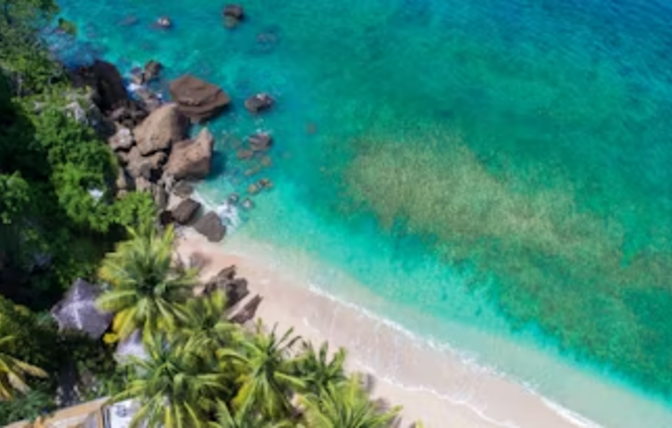

Located in the Indian Ocean's sapphire waters, Seychelles is far more than a tropical paradise. Beyond its postcard-perfect shorelines lies a culturally rich weave created by generations of migration, colonization, and intercontinental trade. In this in-depth travel guide, here, we get to know Seychelles' people, traditions, and music intimately, hitting the very essence of this enchanting archipelago.
A Melting Pot of Cultures: The People of Seychelles
The Creole Seychelles people, or Seychellois, consist of a multicultural blend of African, European, and Asian origins. The multicultural heritage has given rise to a harmonious society in which tradition and culture are revered and celebrated proudly.
Most Seychellois speak Seychellois Creole (Kreol Seselwa) as their primary language, but they also employ English and French. Respect for elders, family, and community harmony are at the core of day-to-day life.
The nation of Seychelles is populated by about 100,000 people, but its culture is vast in its depth. From history and tales to religious ceremonies and paintings, Creole culture is kept alive and is transferred generation after generation.
Traditional Beliefs and Religious Practices
Seychelles' spirituality is mixed, with the majority of the population being Roman Catholic, which was brought to them with French colonialism. Worship is widespread throughout the islands, and religious festivals such as La Fête de l'Assomption and Corpus Christi are chief events.
However, folk belief and ancestral tradition still persist in conjunction with Christianity. Gris-gris (amulets or protection charms) and ancestor sacrifice remain deeply rooted in Seychellois belief systems, more so among rural communities. Such the combination of Christian and African spirituality provides a unique religious aesthetic.
The Rhythms of the Islands: Music and Dance
Music is the beat of cultural identity. Whether in joy during festivals, weddings, or village assemblies, the islands come alive with dynamic rhythms and fervent movement.
Moutya and Sega: The Soul of Seychelles
Moutya, which is a slow, sensual drum dance, emerged during the period of slavery.The dance was performed around bonfires and was once a symbol of protest as well as a symbol of pain and longing. It is now an important part of Seychelloan national heritage and has even been recognized by UNESCO as an intangible cultural heritage.
Sega music, the most melodic and dynamic, blends European melodies with African beats and Caribbean music. Performed on musical instruments such as bongo drums, triangle, and ravanne, sega is performed at most beachside festivals and Creole fairs.
Contemporary Music Scene
Seychelles has a vibrant modern music culture with reggae, dancehall, zouk, and hip-hop. Some of the leading artists include Jean-Marc Volcy, Joseph Sinon, and Sandra Esparon, who merge the old with contemporary rhythms.
Festivals: Celebrating the Creole Spirit
One of the most vivid displays of Seychellois society is at annual festivals, when music, cuisine, fashion, and dance converge to hold society together.
Festival Kreol
Festival Kreol in October is a seven-day fiesta celebrating Creole culture. Parades, traditional shows, and cooking demonstrations, all amid overly decorated streets, encourage visitors and locals to immerse themselves in the authentic spirit of the islands.
A cultural anchor, this festival commemorates the Creole language, values, and identity across the Indian Ocean and beyond.
La Digue Festival
On La Digue Island, August 15th is a festival day celebrated as the Feast of the Assumption, an important Catholic feast. The island becomes a celebration hub with traditional music, regattas, bicycle racing, and dancing.
Creole Cuisine: A Taste of Tradition
Seychelles cuisine is a manifestation of its past. It combines African, French, Indian, and Chinese cuisines to produce a delicious unique cuisine.
Staple Foods
Grilled fish (red snapper and tuna), normally topped with local chili and herbs
Octopus curry, cooked in coconut milk and spice
Shark chutney, shark boiled in a mix of lime, bilimbi, and spice
Ladob, sweet ripe plantains and breadfruit dessert cooked in coconut milk
Street foods such as samosas, cassava chips, and tropical fruits like papaya and starfruit make up the cuisine.
Arts, Crafts, and Oral Traditions
Seychelles cultural heritage is heavily rooted in narration, wood sculpture, and colorful visual arts. The handcraft of islanders supplies markets with baskets made from indigenous fibers, shell jewelry, and painted materials.
Oral traditions, passed down since time immemorial, continue to hold a key position in the transmission of history and moral guidelines. The tales include such folkloric characters as Satans and Tizan (a trickster character) and outline Seychellois' world view.
Architecture: Island Ingenuity and Colonial Legacy
The Seychelles architecture is a testament to its colonial heritage and practical adaptation to tropical life. From the plantation homes with big verandas to the painted wooden houses on stilts, the buildings are both functional and lovely.
Victoria, the capital city, has such monuments as:
The Clock Tower (a replica of London's Vauxhall Clock)
The Cathedral of the Immaculate Conception
The National History Museum, which is home to artifacts and documents summarizing Seychelles' growth
Creole Identity Today
Despite being affected by globalization, Creole identity remains strong. Language, dress, food, and customs are learned in school and emphasized by media, literature, and the arts.
Government efforts such as establishing the Creole Institute operate towards maintaining Creole heritage despite modernization.
The result is a balance of traditional and modern coexisting such that Seychellois youth preserve their roots but are part of the global culture.
Conclusion
Seychelles is more than a tropical getaway—a living cultural treasure house. Its people, traditions, music, and way of life are a reflection of centuries of blended heritage, preserved with pride and devotion. From the moutya drum rhythm to the aroma of octopus curry simmering in coconut milk, Seychelles' culture offers visitors an immersive, unforgettable experience.
If you truly desire to learn about the islands, look past the beaches—welcome the people, dance with them, sample the flavors, and celebrate the spirit of the Seychelles.


